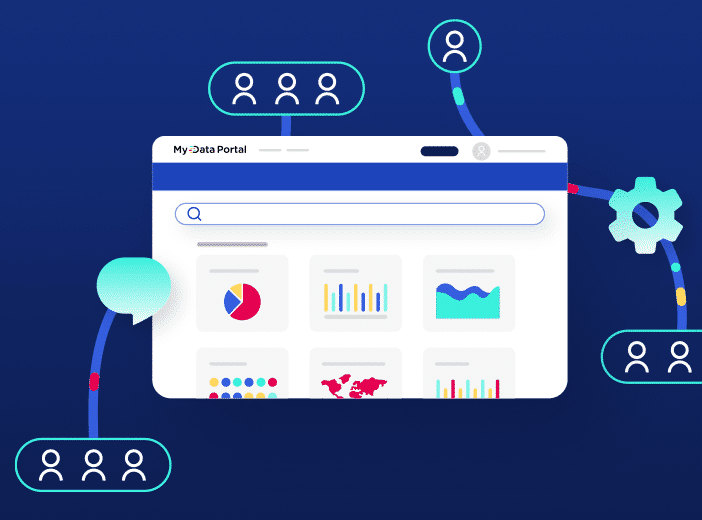The benefits of data lineage for your governance strategy
By helping companies analyze how data is being used, data lineage has a key role in reinforcing successful data governance strategies. Discover all the benefits that data lineage provides to your governance strategy.

Data governance programs aim to ensure organizations benefit from reliable, relevant, compliant and high-quality data. But for your governance strategy to be effective, it’s not enough to define common rules and appoint a Data Governance Officer. Instead, you need to understand how your data is being used and analyze its value to the organization. This is precisely what data lineage is all about. Discover all the benefits that data lineage provides to your governance strategy.
Data governance: an indispensable framework for your data portal
Data governance covers how data collected within an organization is identified, organized, handled, managed and used. Establishing an overall governance strategy is essential to maximizing the use and value of your data within your organization and ecosystem, as well as for protecting it and complying with regulatory obligations.
To build a solid governance strategy organizations need to create common rules for data creation, naming and use, appoint data managers in each department, and disseminate an internal data culture across the business.
However, putting rules in place is not enough. Data governance programs require constant monitoring to ensure that data is used in accordance with defined rules.
It is also crucial to analyze the impact of data on your business by identifying the benefits generated when you make it available and share it more widely. If these benefits are not being achieved, then you need to adapt your strategy to overcome any obstacles.
Data governance and data lineage
By sharing your data on a large scale, whether internally, externally through open data, or with your partners, the overall objective is to enable the creation of new uses for your data. This could be through cross-referencing different datasets, creating data visualizations, or even building new services and applications.
But how do you analyze these value-creating use cases, and ensure that your portal meets the needs of your users?
This is the objective of data lineage, which highlights the relationships between different datasets over time. Essentially data lineage enables you to analyze how data is used within your ecosystem.
Opendatasoft data lineage
Opendatasoft’s data lineage feature was created to enable our customers to automate the analysis of their data usage.
Data administrators have access to :
- detailed mapping that models the journey of a dataset from its point of origin to its point of destination.
- an interactive dashboard that provides more details about how data is being reused.
It includes one-click access to information such as :
- data origin and status (valid or invalid),
- relationships between datasets (federated or joined),
- data modifications and processing,
- the quantity of data reused by ecosystem players,
- the most popular formats for data (maps, pages, datasets, etc.),
- the proportion of external data reused on your portal.
This information is essential to better understand the behavior of your portal’s users and how they interact with data.
Strengthen your governance strategy with data lineage
Thanks to its use-oriented data analysis capabilities, data lineage underpins all the pillars of your governance strategy:
- Processes and common rules for data use: thanks to a better understanding of the needs of data consumers, organizations can optimize the maintenance of their portals and guide their overall strategy,
- Culture and human resources: by demonstrating the value of your data portal, you encourage greater use, reuse and sharing,
- Data tools and solutions: by analyzing the journey of datasets and the most popular formats, organizations can identify solutions and data that are obsolete or do not generate sufficient return on investment.
Improve portal maintenance
With data lineage, teams can visualize data flows in real-time, covering everything from collection via transformation to reuse.
By analyzing how your data is used, you can identify priority actions to maintain your portal and develop your data strategy:
- If a dataset is highly reused: how can it be modified without impacting users? Should you offer more data visualizations built on it?
- A dataset is either not used at all, or has minimal usage: how can it be promoted to users? Should it be deleted?
- There are invalid relationships on my portal: should I contact the producer/consumer of the data? Can I take corrective action?
Reinforce your strategy and define your roadmap
With a better understanding of the data needs of your portal’s users, you can adapt your roadmap to meet their expectations. For example, you could prioritize certain data formats or visualization styles, facilitate the cross-referencing of data between datasets, or encourage meetings with other players to generate new data sources..
Data lineage also provides tangible information you can use to support your analysis and justify your suggestions for improvements.
Demonstrate the value of the portal and engage stakeholders
One of the aims of data sharing is to generate value across your ecosystem by enabling reuse and the creation of new use cases. Yet it is often difficult to analyze the impact of a data portal and see who is using it and for what purposes. With data lineage, organizations can demonstrate the return on investment of their data portal.
Data lineage is therefore an indispensable way to reinforce your governance strategy. It provides concrete information about how your portal and its data is being used, enabling you to make decisions and improvements based on hard facts.
Want to find out more about our data lineage functionality? Read our article on the subject.




